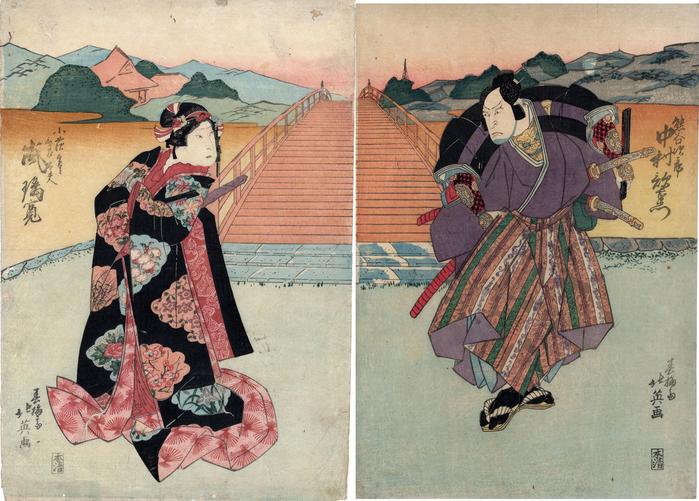Shunbaisai Hokuei (春梅斎北英) (artist )
Nakamura Utaemon III (中村歌右衛門) as the warrior Kumagai Jirō Naozane (熊谷次郎) and Arashi Rikan II as Kohagi (小萩無官太夫) at the Gojō Bridge.
11/1835
10 in x 14.75 in (Overall dimensions) color woodblock print
Signed: Shunbaisai Hokuei ga
春梅斎北英画
Publisher seal: Honya Seishichi
(Marks 123 - seal 25-527)
Waseda University - right panel
Waseda University - left panel
Museum of Fine Arts, Boston
National Museums Scotland - left panel only
Lyon Collection - Hokkei print of Kohagi
Victoria and Albert Museum - the full diptych Waseda University identifies this play as Suma no Miyako Gempei Tsutsuji (須磨都源平躑躅). In that play the young and handsome Taira Atsumori, dressed as a woman named Kohagi, meets Kumagai Jirō Naozane at the foot of Gojō Bridge. Atsumori has taken on this disguise to escape his enemies. He has taken refuge in the shop/home of a former retainer Kazusa who now makes fans in the Gojō district of Kyoto. The fan-maker's daughter Katsurako falls in love with the youth. Before he is discovered Samuel L. Leiter notes of the scene between Katsurako and Kogahi (aka Atsumori) that "There are no other lesbian-like love scenes in kabuki like the one between [these two]."
Among the many flowers and decorative elements on Kohagi's robes is one mandarin orange or tachibana (橘), seen on her obi. This is the crest of this actor, Arashi Rikan II. Two of them also appear as baubles hanging among her hair decorations.
****
Timothy Clark wrote of a painting in the British Museum:
The death of the young Taira warrior Atsumori at the hands of Kumagai Jiro Naozane at the battle of Ichinotani has already been described... Encounters between the two became elements of many Kabuki plays, including 'Suma no Miyako Gempei tsutsuji' (also known as 'Ogiya Kumagai') in which the plot was transferred to Kyoto. In 1832 the scene depicted on this large theatre signboard, the encounter at Gojo Bridge, was added to be performed by the great Nakamura Utaemon III and has been an integral part of the play ever since. The fight between the handsome young Atsumori and Kumagai, with his fierce red makeup, was a reworking of the encounter between Ushiwaka-maru (the young Minamoto no Yoshitsune) and the warrior-monk Benkei at the same spot, a story well known to all.****
There is another copy of this diptych in the Los Angeles County Museum of Art, but it is not illustrated online.
****
There is another print in the Lyon Collection of Atsumori dressed as Kohagi. It is by Hokkei and dates from 1818. Click on the link above to see it.
****
Illustrated:
1) in a black and white reproduction in Japanese Illustrations; a History of the Arts of Wood-cutting and Colour Printing in Japan by Edward Fairbrother Strange, George Bell and Sons, 1907, (description on page 96, illustration unpaginated). [Not all copies of this edition show the image, but do include the text anyway. Stange wrote: "Our next plate, by a pupil of Hokusai, Hokuyei, has rather the style and manner of the early followers of Toyokuni than that which the artist's name would lead us to expect. It is signed Shunkosai Hokuyei, and represents the actors Nakamura Utazemon and Arashi Rikan in a theatrical scene. The publisher's name is Honya Seibei. The perspective of the receding bridge is a noticeable feature of this composition."
"Hokuyei also made use of the signatures Shumbaisai, Shumbaitei, and Sekkwaro, often signing his prints Shunkosai simply, and in some instances '' Shunkosai, pupil of Shunsho." In fact, the signatures on the Osaka broadsheets all point in the direction we have suggested."
2) in color in a small reproduction in Hokuei: Master of Osaka Kabuki Prints by John Fiorillo, Ludion, 2024, cat. 217, page 195. John Fiorillo notes that the figure of Kohagi is in fact that of Mukan Tayu Atsumori (小萩実は無官太夫敦盛) [this is the name/description as listed at the Museum of Fine Arts in Boston - slightly different to that of this author] in the play Azaleas of the Minamoto and Taira Clans in the Capital of Suma (Suma no miyako Genpei tsutsuji 須磨都源平躑躅) at the Naka Theater in Osaka.
Honya Seishichi (本屋清七) (publisher)
Nakamura Utaemon III (三代目中村歌右衛門) (actor)
Arashi Rikan II (二代目嵐璃寛: 9/1828 - 6/1837) (actor)
Kyōto-Osaka prints (kamigata-e - 上方絵) (genre)
actor prints (yakusha-e - 役者絵) (genre)
Ichinotani Futaba Gunki (一の谷嫩軍記) (kabuki)
Kumagai Jirō Naozane (熊谷直実) (role)
